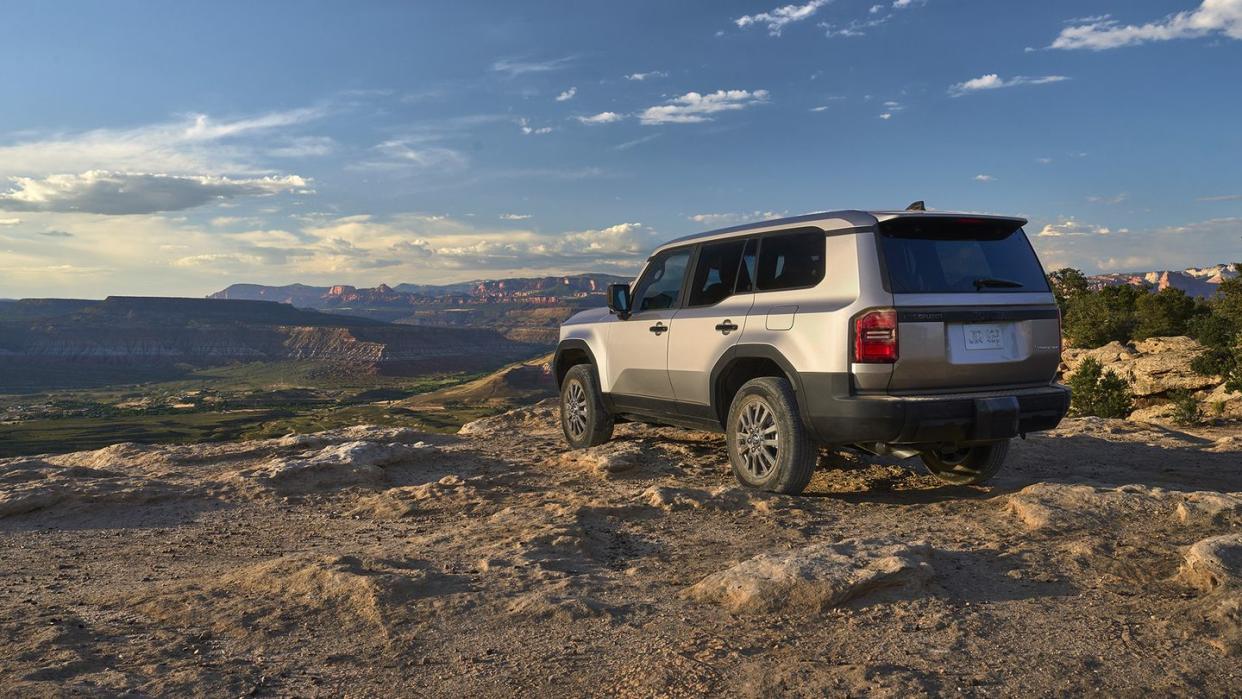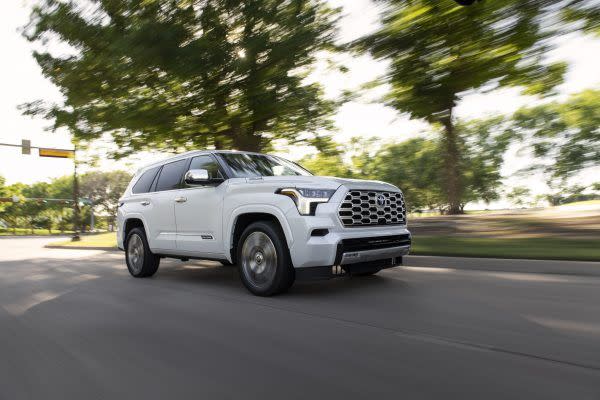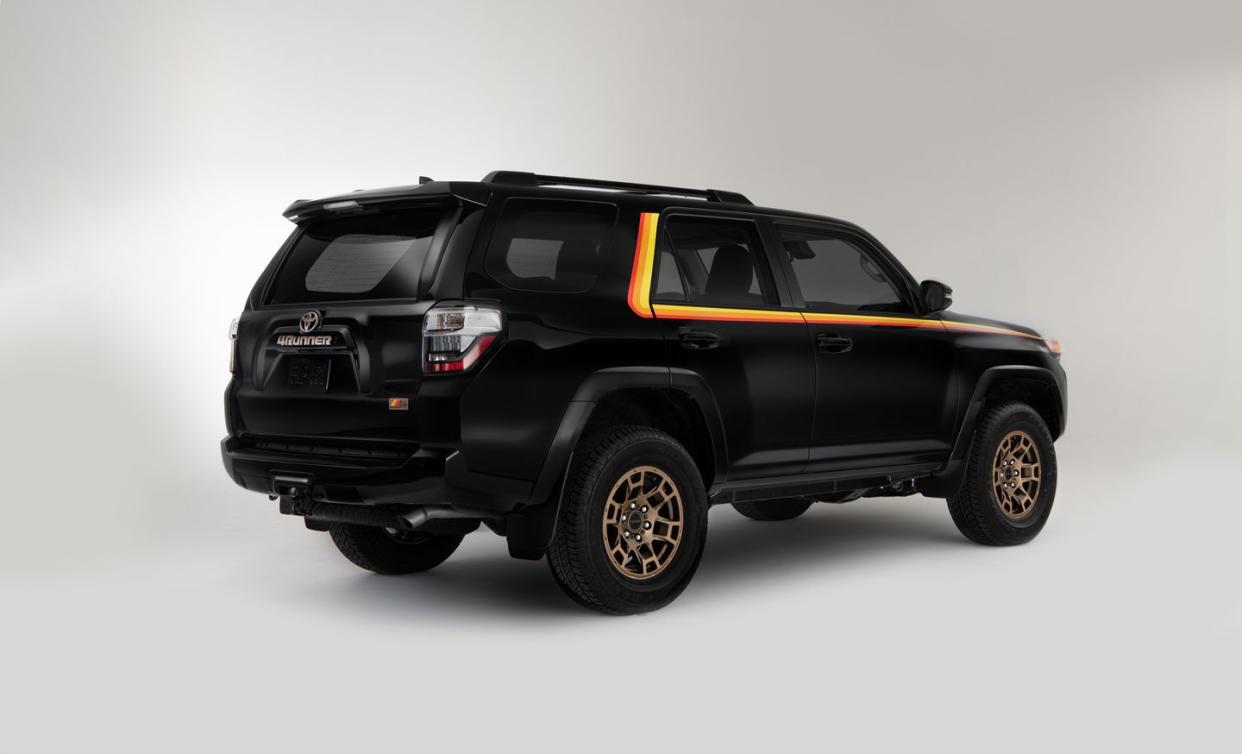To Save the Land Cruiser, Toyota First Had to Kill It

Toyota's lineup was predictable and hierarchical once: Sequoia for the family, 4Runner in the middle, and Land Cruiser at the top, where it didn't garner a lot of sales.
Over at Lexus, there were big grilles and luxury versions of the Toyota SUVs, but those were never intended for off-roading.
The solution to getting the Land Cruiser out of its niche role, it seems, was to reinvent it, and Toyota has done just that.
In the past, Toyota's U.S. off-road SUV product lineup had a distinct hierarchy. The Land Cruiser sat at the top, with the 4Runner just below and the Sequoia over in the family room. The parallel Lexus universe had more luxurious and expensive versions of the Land Cruiser and 4Runner, but they had less clearance due to low-hanging fascia designs and increasingly humongous grilles. Despite having the same stellar running gear (and even more power in the case of the GX) the Lexus variants have always been more susceptible to body damage and are too superficially delicate to beat up off-road.

Thing is, the Land Cruiser at the top was too expensive for off-roaders to afford. Most lived their lives as pavement-bound mall wagons that never touched earth until they lost their shine, racked up 100,000 miles, and dropped in value before they were bought by enthusiasts. Over time, its reputation was more theoretical than anything else, based in history and the exploits of models that were only available overseas. Starting with the 100-series, the only Land Cruiser we ever got was the expensive three-row behemoth with independent front suspension, a thirsty V-8 engine, and an automatic. As a result, U.S. Land Cruiser sales have been dismal, with annual sales averaging just 3200 units over the past decade.

Meanwhile, the smaller and more affordable 4Runner has been selling briskly, with sales averaging some 130,000 units per year since 2016. The current fifth-generation model is still having a great run even though it debuted in 2009 as a 2010 model.
What happened? Overland-style off-road camping started to get popular right at the time many body-on-frame SUVs morphed into crossovers. Toyota even made the decision to kill off the FJ Cruiser in this period. People started seeking out the few remaining off-road frame-based SUVs and modding them for backcountry camping. With few used Land Cruisers to buy, new 4Runners were a great choice.
TGNA-F Stirs the Pot
The arrival of the highly malleable TGNA-F truck platform and new downsized turbo engines with hybrid variants brought an opportunity for a brand reset. The Tundra changed from leaf spring rear suspension to TGNA's coils, while the Sequoia went the other way from independent rear suspension to TGNA's solid axle. Whether you agree with it or not, the latter became a more off-road-capable three-row large SUV in an instant, making it difficult to make a case for the same sort of Land Cruiser in the U.S. TGNA would also underpin the new global 300-series Land Cruiser, but Toyota decided to use the opportunity to recast our Land Cruiser as a more affordable two-row off roader. Lexus, on the other hand, said yes to the 300-series and introduced it as the 2022 LX600.
For years, other markets have had access to the Land Cruiser Prado, a smaller and less expensive Land Cruiser variant with independent front suspension and smaller engines. Markets that still sold the big Cruiser with solid axle front suspension could easily make a marketing distinction, but that differentiation hasn't existed here for some time. The idea of moving the 2024 Land Cruiser in the Prado direction isn't nearly the shock to the system it would be in other parts of the world. Using this approach to remove cost and make the Land Cruiser more affordable makes sense here, because our "big" Land Cruiser was a dud, sales-wise.
How It Played Out
With the Sequoia taking on three-row duties, transforming the Land Cruiser into a smaller, five-passenger Prado-style off-roader is a beneficial move—especially if going off-road and cruising actual land is your thing. Parking, too. The TGNA platform makes that easy to execute, and it results in a 250-series Prado-based SUV that's not that different from the 300-series LX600 from the standpoint of the frame, suspension, and four-wheel drive system. In fact, both share a wheelbase of 112.2 inches and have similar track widths. But the 250-series Prado is on a different development cycle, so Toyota had to "kill off" the Land Cruiser to make the switch.
When the dust settles, the Land Cruiser and the new GX550 (the GX has always been Prado-based) will occupy the same strata, but with the usual Lexus differences. The GX will be notably longer, taller, more luxurious, and have less favorable approach and underbody clearance dimensions. It'll be powered by a slightly more powerful (and thirstier) 3.4-liter twin-turbo V-6. It's bound to be considerably more expensive too. Along those lines, the new GX550 will be fitted with the new and improved e-KDSS stabilizer bar disconnect system, while the Land Cruiser shies away from that in favor of a less expensive front stabilizer bar disconnect. Toyota seems to be serious about returning the Land Cruiser to more minimalist roots to keep it affordable.
One Last Domino
All of this begs a question: What about the 4Runner? It has not yet made the switch to the TNGA-F architecture and the new engines that come along with it. The downsized Land Cruiser would still need to be the larger and more desirable offering, but the space between them has shrunk. Will its wheelbase remain shorter and its width narrower than the Land Cruiser? Toyota is mum about any new 4Runner specifics, except to say it's not going anywhere.
We think the new 4Runner will slot in at a lower price point by using the Tacoma's part-time four-wheel-drive system and midlevel engine offering. The rear differential lock and MTS and Crawl Control systems will only appear on the TRD Off-Road and Pro models, as they do now. The high-performance TRD Pro will probably continue, as that would distinguish the 4Runner from the more overlanding-focused Land Cruiser.
Was all of this a good idea? It is if you like the idea of having a Land Cruiser in your garage. The sales pace of the old one was not sustainable, and its hulking size and expensive price were never compatible with the apparent mission statement that's right there in the Land Cruiser's very name. To save the Land Cruiser, Toyota had no choice but to kill it first.
You Might Also Like
